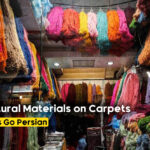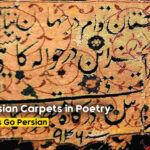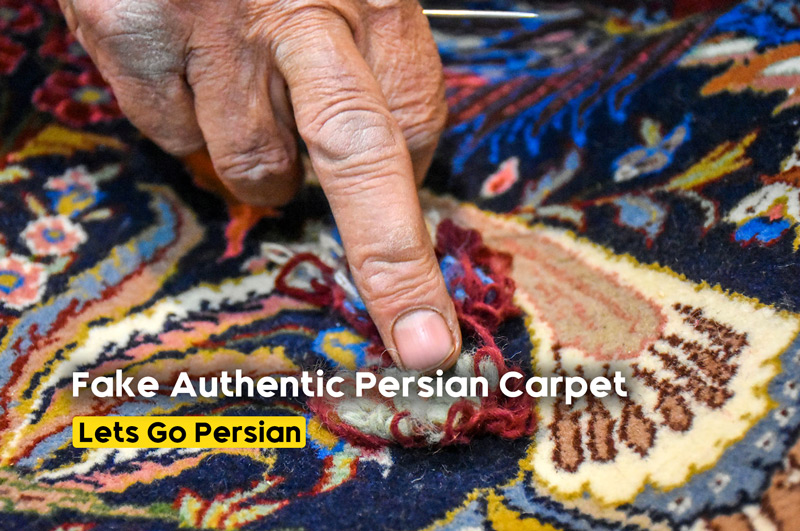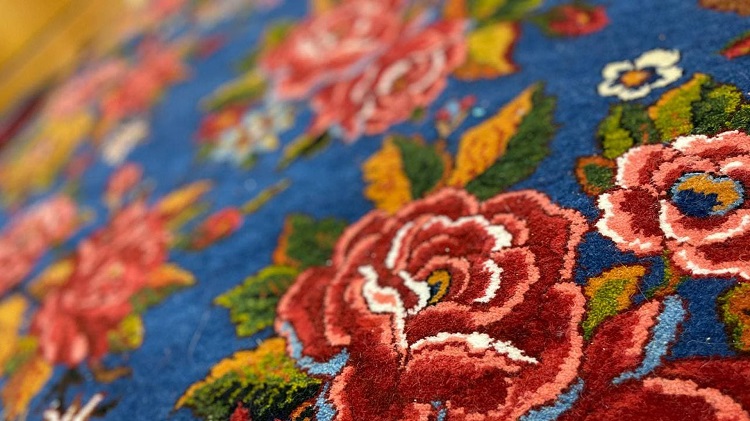
The Impact of Colors and Natural Materials on the Quality of Persian Carpets

The Role of Carpets in Persian Literature and Poetry
Authentic Persian carpets are treasured works of art, known for their intricate designs, master craftsmanship, and use of natural materials. However, the global demand for these rugs has led to a market flooded with imitations and machine-made replicas. Knowing how to distinguish a genuine Persian carpet from a fake can help you make informed decisions when purchasing, ensuring you get the quality and craftsmanship you desire. In this guide, we will explore the key characteristics of authentic Persian carpets and offer tips on how to spot a fake.

How to Distinguish an Authentic Persian Carpet from a Fake
1. Look at the Back of the Carpet: Hand-Knotted vs. Machine-Made
Hand-Knotted Carpets
The first and most reliable way to determine if a Persian carpet is authentic is to examine the back of the rug. Hand-knotted Persian carpets display a distinctive texture and pattern on the reverse side, where the knots are visible.
- Visible Knots: In an authentic hand-knotted Persian carpet, you can see individual knots on the back. The knots may not be perfectly uniform, as each knot is tied by hand, which adds to the uniqueness of the rug.
- No Backing or Glue: A genuine Persian carpet has no additional backing or glue on the underside. If you see any synthetic backing, it’s likely a machine-made rug.
- Flexibility: Authentic Persian carpets are more flexible and can be folded easily without damaging the structure. This flexibility is due to the hand-knotting technique.
Machine-Made Carpets
Machine-made carpets often have a smoother, more uniform backing that lacks the distinctive knot structure of a hand-knotted rug.
- Perfectly Uniform Pattern: The back of a machine-made rug will appear too perfect and symmetrical. You won’t see the individual knots, and the pattern may look identical to the front.
- Synthetic Backing: Many machine-made carpets have a synthetic backing for added durability, which is a clear sign that the carpet is not hand-woven.
2. Check the Materials: Wool, Silk, and Natural Dyes
Authentic Materials
Authentic Persian carpets are made from natural materials such as wool, silk, or a blend of both. The type and quality of these materials significantly affect the feel, durability, and appearance of the rug.
- Wool: High-quality wool, often sourced from local sheep, is the most common material in Persian carpets. Authentic wool feels soft yet durable, with a natural sheen that synthetic fibers can’t replicate.
- Silk: Some Persian carpets are woven entirely from silk, or silk is used to highlight intricate designs. Silk carpets have a distinct lustrous shine and feel exceptionally smooth to the touch.
- Natural Dyes: Persian carpets are traditionally dyed with natural dyes from plants, minerals, and insects. The colors in an authentic Persian carpet will have depth and subtle variations (known as abrash), unlike synthetic dyes, which often appear overly bright or flat.
Fake Materials
Imitation Persian carpets often use synthetic fibers like nylon, polyester, or polypropylene. These materials lack the richness, warmth, and durability of natural wool or silk.
- Shiny and Plastic-Like: Synthetic fibers often have an artificial, overly shiny appearance, and they can feel rough or plastic-like to the touch.
- Bright, Unnatural Colors: Machine-made carpets using synthetic dyes often have unnaturally bright colors that don’t age well over time, unlike the natural patina of authentic dyes.
3. Inspect the Fringes: Part of the Weaving or Sewn On?
Genuine Persian Carpet Fringes
In an authentic Persian carpet, the fringes are an extension of the rug’s structure. They are the warp threads that form the foundation of the carpet and are integral to its overall construction.
- Continuous with the Carpet: The fringes should be part of the rug’s foundation and not sewn on afterward. When you look at the back of the rug, the fringes should continue from the warp threads of the weave.
- Unevenness: In a hand-woven carpet, the fringes may not be perfectly even or uniform, as they are part of the handmade process.
Fake Carpet Fringes
In fake or machine-made carpets, the fringes are often sewn on as a decorative element after the rug is produced.
- Attached Separately: If the fringes look like they have been stitched or glued to the edges of the rug, it’s a sign that the carpet is machine-made or inauthentic.
- Perfect Uniformity: Machine-made fringes will often appear too perfect and uniform, lacking the irregularity of hand-tied fringes.
4. Examine the Design and Patterns: Cultural Significance and Symmetry
Authentic Persian Carpet Designs
Authentic Persian carpets feature traditional designs and patterns, many of which have been passed down through generations of weavers. These patterns often hold cultural and symbolic significance, and while symmetrical, they retain a degree of organic variation.
- Floral, Geometric, or Medallion Patterns: Authentic Persian carpets often feature floral motifs, geometric patterns, or central medallions. Each region in Iran has its distinctive style, such as the floral elegance of Isfahan carpets or the bold tribal patterns of Qashqai rugs.
- Slight Asymmetry: While Persian carpets are often symmetrical in design, slight variations and irregularities in the pattern are common in handmade rugs. These variations are signs of the rug’s authenticity, as no two hand-made carpets are exactly alike.

Floral motifs
Fake Carpet Designs
Machine-made carpets often feature repetitive, overly perfect designs that lack the subtle variations found in handmade Persian rugs. They may imitate Persian patterns but lack the cultural depth and individuality of authentic pieces.
- Too Perfect Symmetry: Machine-made rugs often have exactly symmetrical patterns with no variations, which can be a clear sign that the carpet was not made by hand.
- Inauthentic Patterns: Some fakes may mimic traditional Persian designs but do not follow the intricate details and symbolism that true Persian carpets embody.
5. Evaluate the Knot Density: Fineness of the Weave
Knot Density in Authentic Persian Carpets
Knot density, measured in knots per square inch (KPSI) or knots per square meter (KPSM), is another important factor in determining the authenticity and quality of a Persian carpet.
- High Knot Density: Authentic Persian carpets, especially those from regions like Tabriz or Isfahan, tend to have high knot densities, often between 200 and 500 KPSI. Higher knot density allows for more intricate designs and greater detail.
- Visible Knotting: When you look closely at the back of the rug, you should see individual knots. The more knots, the finer and more detailed the carpet.
Machine-Made Carpets
Machine-made carpets typically have a lower knot density or no visible knots at all, as they are produced by automated processes.
- Uniform and Loose Knots: If the knots are perfectly uniform and lack the tightness found in hand-knotted carpets, it’s likely a machine-made product.
- Low Knot Count: Machine-made carpets often have fewer knots per square inch, resulting in less detail and clarity in the design.
6. Consider the Price: Authenticity Comes at a Cost
Authentic Carpets
Authentic Persian carpets are a result of painstaking craftsmanship, which is reflected in their price. A hand-woven Persian carpet with natural materials and intricate designs is an investment, often costing more than mass-produced imitations.
- Price Reflects Craftsmanship: Genuine Persian carpets can range from several hundred to thousands of dollars, depending on factors such as knot density, materials, and region of origin.
- Certificates of Authenticity: When purchasing an authentic Persian carpet, reputable sellers may provide certificates of authenticity, especially for high-value pieces. Always ask for documentation that confirms the rug’s origin.
Fake Carpets
If the price seems too good to be true, it probably is. Machine-made or fake carpets are typically sold at a fraction of the cost of authentic Persian carpets, but they lack the craftsmanship and durability of the real thing.
- Suspiciously Low Prices: Beware of carpets sold at low prices that claim to be Persian. Machine-made imitations are often mass-produced and lack the fine craftsmanship of authentic pieces.
Conclusion
Distinguishing an authentic Persian carpet from a fake requires attention to detail, from inspecting the back for hand-knotted craftsmanship to evaluating the materials, dyes, and designs. Authentic Persian carpets are made with natural fibers, intricate hand-woven designs, and traditional dyeing techniques, making them timeless pieces of art. By understanding these key characteristics, you can confidently identify a genuine Persian carpet and avoid fakes, ensuring that your investment is a valuable and lasting addition to your home.



















